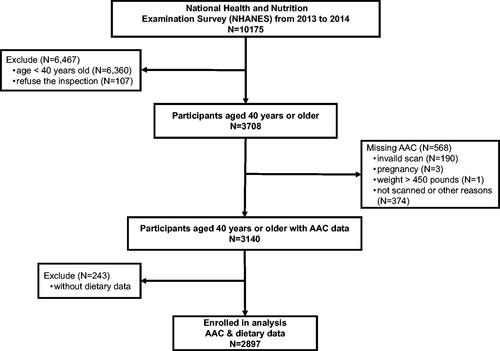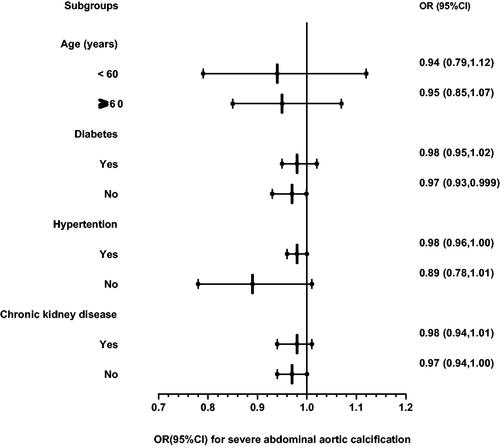Figures & data
Figure 1. Screening flow of participants included in the research. A total of 10,175 participants from the 2013–2014 NHANES were recruited for this study. The AAC score was measured by a dual-energy X-ray absorptiometry (DXA) scan. A total of 3140 participants completed DXA scans and obtained available data. Diet-derived antioxidants were obtained from 24-h dietary recall interviews. After excluding 243 participants who did not undergo 24-h dietary recall interviews, 2897 participants were included in the analysis. NHANES: National Health and Nutritional Examination Survey; AAC: abdominal aortic calcification.

Figure 2. Subgroup analysis for the association between diet-derived lycopene and AAC. Subgroup analysis stratified by age, hypertension, diabetes, and CKD was also performed using stratified multivariate logistic regression analysis. *Logistic regression model adjusted for variables in age, sex, marital status, race/ethnicity, body mass index, diabetes, hypertension, smoking history, eGFR, Haemoglobin A1c, TC/HDL, mean SBP, mean DBP, and diet-derived antioxidants. AAC: abdominal aortic calcification; CKD: chronic kidney disease; eGFR: estimated glomerular filtration rate; TC: total cholesterol; HDL: high-density lipoprotein; SBP: systolic blood pressure; DBP: diastolic blood pressure; OR: Odds ratio; CI: confidence interval.

Table 1. Characteristics and dietary antioxidant assessment based on no, mild-moderate, and severe calcification in the ACC of participants.
Table 2. Multivariate analysis to evaluate associations between AAC group and diet-derived antioxidants in included participants*.
Table 3. Multivariate analysis to evaluate associations between the AAC group and other relevant covariates in included participants*.
Supplemental Material
Download MS Word (21.5 KB)Data availability statement
The data used in this study are freely available from the following sources: https://www.cdc.gov/nchs/nhanes/index.htm.
